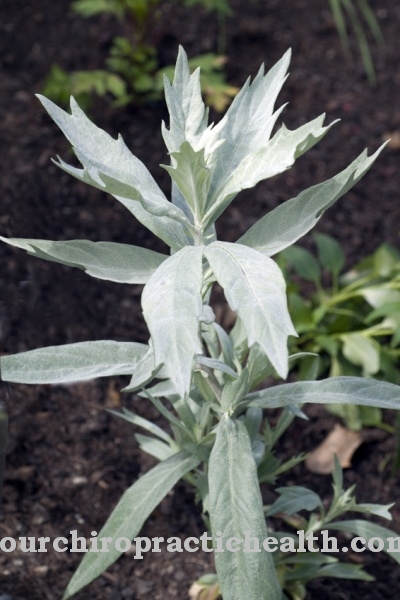Of the Common flax is one of the traditional medicinal plants. Among other things, it is used in the form of flaxseed.
Occurrence and cultivation of the common flax

The common flax is an annual plant and reaches a height of between 30 centimeters and 1.50 meters. Its leaves are very narrow and have the shape of a lancet. The color of the five-fold flowers is white-blue to blue. They show up in the months of June to August. Their diameter is about two to three centimeters. The flax seeds emerge from the flowers. There are eight to ten seeds in each of the round flower capsules. They can be harvested between August and October.
Flax is grown as a crop all over the world. The home of the plant can be found in the Mediterranean region as well as in the Middle East. The undemanding medicinal herb thrives best in a temperate climate. Flax prefers sun and nutrient-rich soil for growth.
Effect & application
The ingredients in flax include mucilage, linoleic acid, fiber, amino acids, lignan glycosides, cyanogenic glycosides, unsaturated fatty acids, proteins, phosphatides, as well as triterpenes and sterols. Flax seeds and leaves are used for medicinal purposes. The flowers are also of interest for homeopathy.
Various therapeutic effects are ascribed to flax. It has anti-inflammatory, laxative, emollient, analgesic and antispasmodic effects. The most important medicinal components of the plant are the flax seeds, which contain health-promoting mucilage and various B vitamins as well as vitamin E. Since the flaxseeds stimulate the intestines, they are used as a laxative.
The flax seeds are administered for internal consumption. To do this, the patient mixes one or two tablespoons of ground flaxseed with liquid, muesli or yogurt. Because of their moisture, the flaxseed swells up a little and releases mucus. Before taking it, the patient lets the flaxseed work a little longer, after which it can be eaten. It is important to drink about half a liter of water after taking it. This gives the flaxseed the opportunity to swell up completely within the gastrointestinal tract.
This causes the stool to soften, which can then pass through the intestines more easily. The flax seeds are taken two or three times a day. The flaxseed can also be brewed as a tea. This has a positive effect on the urinary system. The healing seeds can also be used externally. For this purpose, the seeds are ground or crushed and applied in the form of a poultice for coughs, ulcers or inflammation of the skin. You can also use poultices made from boiled pulp against boils.
Supplemented with olive oil or honey, the healing effect is increased. Linseed oil, which is pressed from linseed, is suitable for rashes on the skin. The oil can be used both in the form of compresses and as an opening enema. In the case of biliary colic, the oil can also be taken internally. The dose is 50 grams per drink. A spoonful of linseed oil per day is also said to prevent a heart attack. The linseed oil can also be processed into an ointment and is used to treat inflamed wounds.
Importance for health, treatment & prevention
The common linseed has been used for therapeutic purposes since ancient times and in the Middle Ages. Theophrast and Hildegard von Bingen already knew how to appreciate its positive effects on health. The mucilage in the flaxseed acts as a swelling agent in the intestine. If there is a bond between the seeds and water in the gastrointestinal tract, this leads to their swelling, which in turn increases the volume of the intestinal contents. This has positive effects on digestion.
The fatty oil in the flaxseed has a kind of lubricating effect, which means that the intestinal contents are removed more quickly. However, in order for the flax seeds to develop their full potential, the patient must drink plenty of fluids. It can take two to three days for them to develop their laxative effects.
Other areas of application for linseed or linseed oil are sore throats, hoarseness, sore throat, runny nose, swelling of the glands, facial neuralgia, skin rash, shingles, toothache, boils and ulcers. Flax is also used to treat sciatica, rheumatism, psoriasis, over-acidification of the stomach, inflammation of the gastric mucosa, heartburn and abdominal complaints.
Homeopathy also uses common flax as a remedy for hay fever, bronchial asthma, hay fever, irritation of the urinary bladder or paralysis of the tongue. There are, however, some contraindications. For example, flaxseed should not be taken if the patient has had an obstruction in the intestines or is suffering from constrictions in the stomach or esophagus.
During pregnancy, women should rather avoid using linseed oil, because taking it increases the risk of premature birth. In addition, flaxseed can limit the absorption of medication in the intestinal area. For this reason, it is not advisable to take flaxseed and other medicines at the same time.



























